Childhood Obesity: A Sociological Analysis of Indigenous Schools
VerifiedAdded on 2023/01/17
|11
|2587
|85
Essay
AI Summary
This essay provides a sociological analysis of childhood obesity within Indigenous schools in Canada. It begins with an introduction that highlights the prevalence of obesity among Indigenous children, emphasizing the impact of factors like early life events, school policies, colonization, and food insecurity. The essay utilizes sociological theories, including the fundamental cause theory and structural-functionalism, to examine the issue. The content section presents statistics and discusses the impact of obesity on healthcare, the economy, and the quality of life for Indigenous children. The analysis delves into the role of social inequality, government policies, and socioeconomic factors in exacerbating the problem. The essay then explores the fundamental cause theory, which explains how socioeconomic factors are key determinants of illness, and structural-functionalism, which views healthcare as a social institution that maintains health and well-being. A critical sociological analysis highlights the power dynamics and stratification systems within Canadian society that affect access to resources and programs for Indigenous communities. The essay concludes by reiterating the need for policies and programs to promote healthy behaviors and address the existing disparities between Indigenous and non-Indigenous schools.
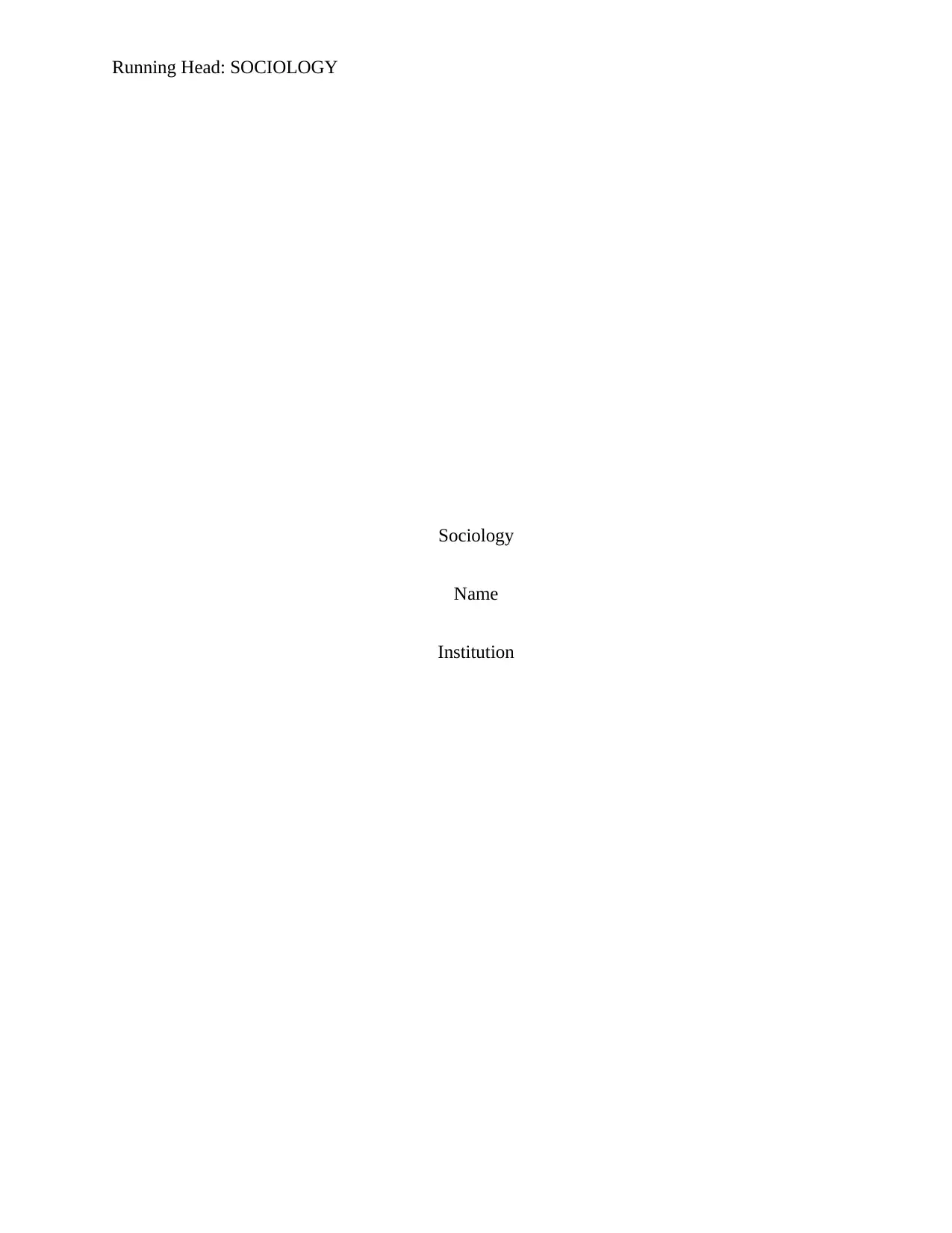
Running Head: SOCIOLOGY
Sociology
Name
Institution
Sociology
Name
Institution
Paraphrase This Document
Need a fresh take? Get an instant paraphrase of this document with our AI Paraphraser
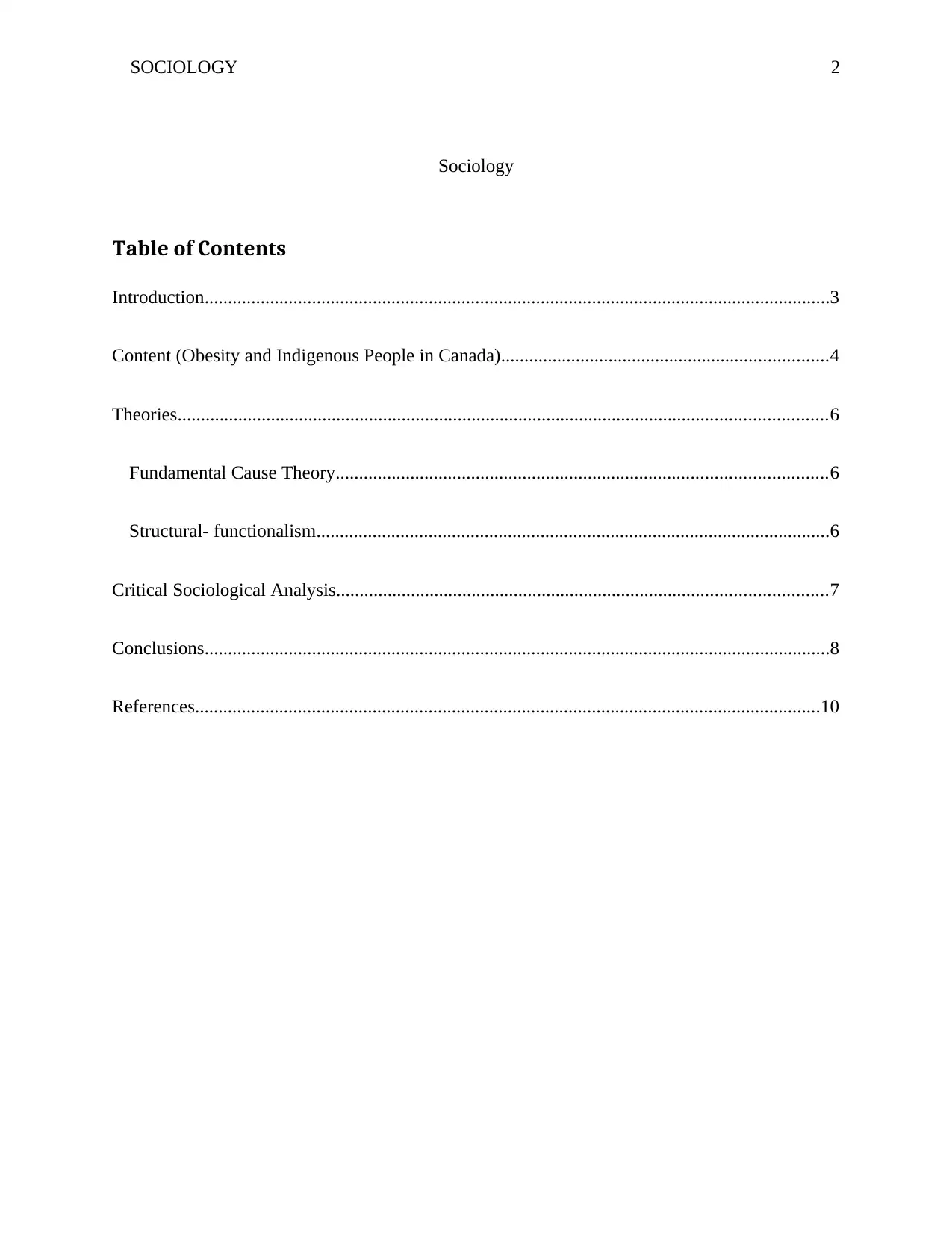
SOCIOLOGY 2
Sociology
Table of Contents
Introduction......................................................................................................................................3
Content (Obesity and Indigenous People in Canada)......................................................................4
Theories...........................................................................................................................................6
Fundamental Cause Theory.........................................................................................................6
Structural- functionalism..............................................................................................................6
Critical Sociological Analysis.........................................................................................................7
Conclusions......................................................................................................................................8
References......................................................................................................................................10
Sociology
Table of Contents
Introduction......................................................................................................................................3
Content (Obesity and Indigenous People in Canada)......................................................................4
Theories...........................................................................................................................................6
Fundamental Cause Theory.........................................................................................................6
Structural- functionalism..............................................................................................................6
Critical Sociological Analysis.........................................................................................................7
Conclusions......................................................................................................................................8
References......................................................................................................................................10
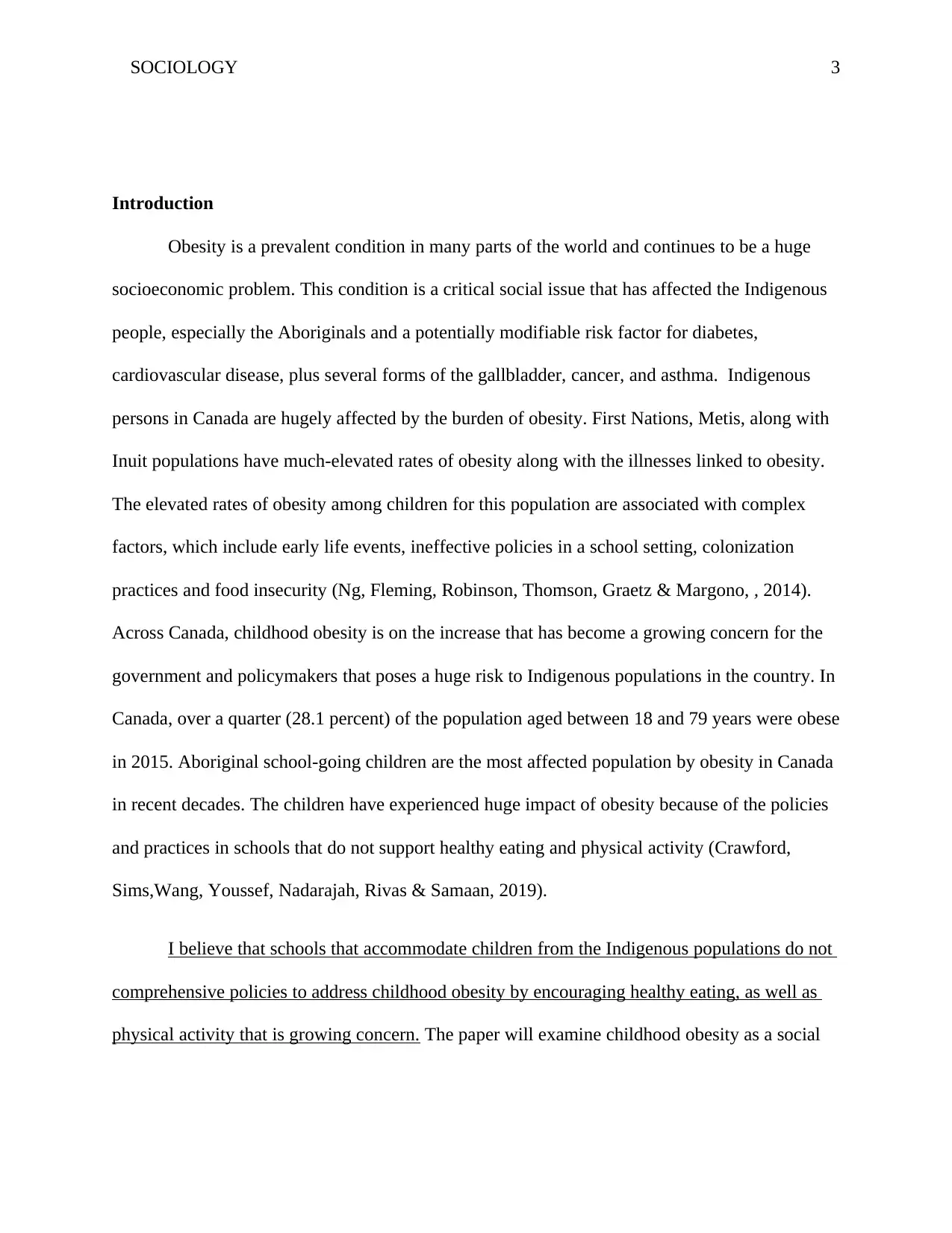
SOCIOLOGY 3
Introduction
Obesity is a prevalent condition in many parts of the world and continues to be a huge
socioeconomic problem. This condition is a critical social issue that has affected the Indigenous
people, especially the Aboriginals and a potentially modifiable risk factor for diabetes,
cardiovascular disease, plus several forms of the gallbladder, cancer, and asthma. Indigenous
persons in Canada are hugely affected by the burden of obesity. First Nations, Metis, along with
Inuit populations have much-elevated rates of obesity along with the illnesses linked to obesity.
The elevated rates of obesity among children for this population are associated with complex
factors, which include early life events, ineffective policies in a school setting, colonization
practices and food insecurity (Ng, Fleming, Robinson, Thomson, Graetz & Margono, , 2014).
Across Canada, childhood obesity is on the increase that has become a growing concern for the
government and policymakers that poses a huge risk to Indigenous populations in the country. In
Canada, over a quarter (28.1 percent) of the population aged between 18 and 79 years were obese
in 2015. Aboriginal school-going children are the most affected population by obesity in Canada
in recent decades. The children have experienced huge impact of obesity because of the policies
and practices in schools that do not support healthy eating and physical activity (Crawford,
Sims,Wang, Youssef, Nadarajah, Rivas & Samaan, 2019).
I believe that schools that accommodate children from the Indigenous populations do not
comprehensive policies to address childhood obesity by encouraging healthy eating, as well as
physical activity that is growing concern. The paper will examine childhood obesity as a social
Introduction
Obesity is a prevalent condition in many parts of the world and continues to be a huge
socioeconomic problem. This condition is a critical social issue that has affected the Indigenous
people, especially the Aboriginals and a potentially modifiable risk factor for diabetes,
cardiovascular disease, plus several forms of the gallbladder, cancer, and asthma. Indigenous
persons in Canada are hugely affected by the burden of obesity. First Nations, Metis, along with
Inuit populations have much-elevated rates of obesity along with the illnesses linked to obesity.
The elevated rates of obesity among children for this population are associated with complex
factors, which include early life events, ineffective policies in a school setting, colonization
practices and food insecurity (Ng, Fleming, Robinson, Thomson, Graetz & Margono, , 2014).
Across Canada, childhood obesity is on the increase that has become a growing concern for the
government and policymakers that poses a huge risk to Indigenous populations in the country. In
Canada, over a quarter (28.1 percent) of the population aged between 18 and 79 years were obese
in 2015. Aboriginal school-going children are the most affected population by obesity in Canada
in recent decades. The children have experienced huge impact of obesity because of the policies
and practices in schools that do not support healthy eating and physical activity (Crawford,
Sims,Wang, Youssef, Nadarajah, Rivas & Samaan, 2019).
I believe that schools that accommodate children from the Indigenous populations do not
comprehensive policies to address childhood obesity by encouraging healthy eating, as well as
physical activity that is growing concern. The paper will examine childhood obesity as a social
⊘ This is a preview!⊘
Do you want full access?
Subscribe today to unlock all pages.

Trusted by 1+ million students worldwide
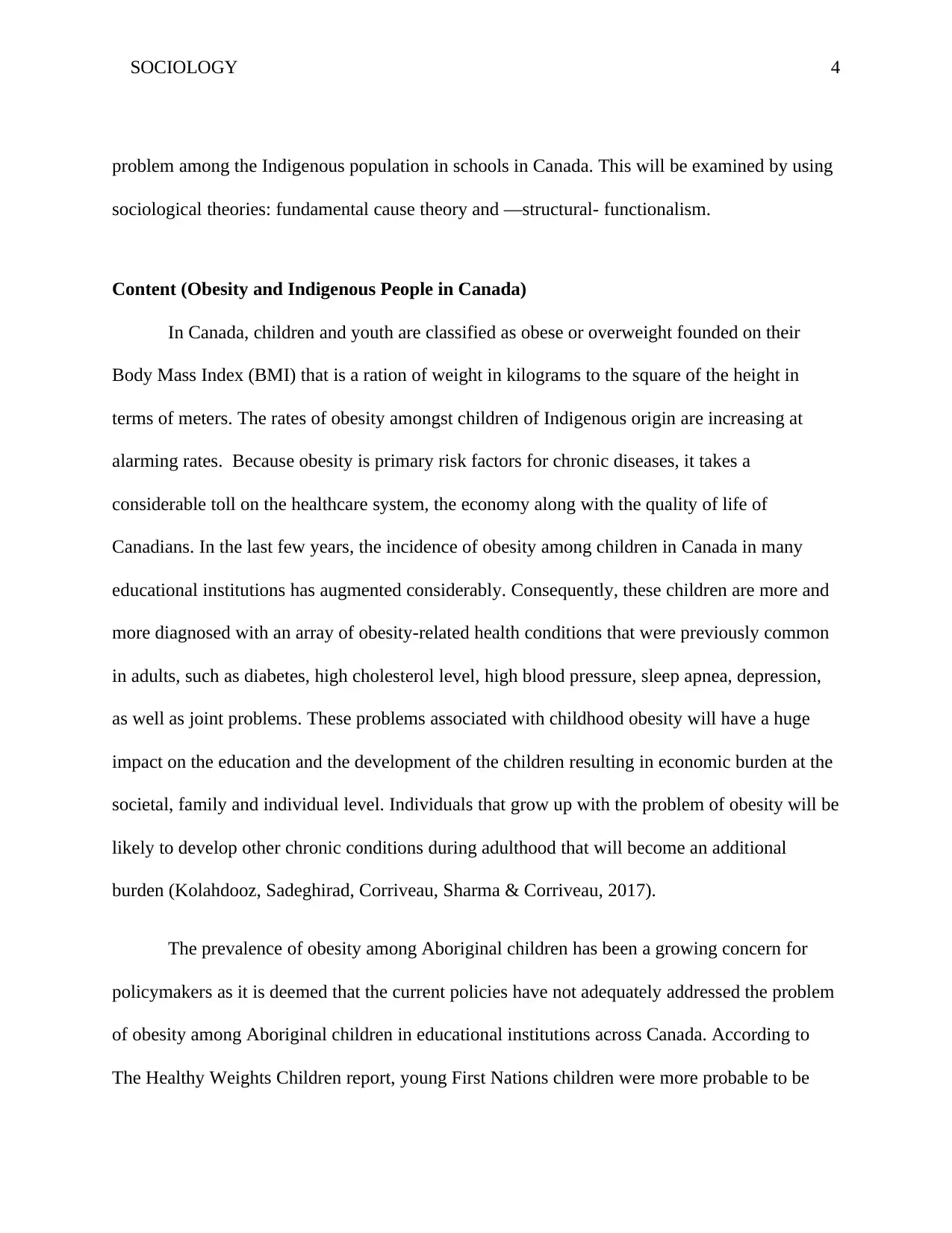
SOCIOLOGY 4
problem among the Indigenous population in schools in Canada. This will be examined by using
sociological theories: fundamental cause theory and —structural- functionalism.
Content (Obesity and Indigenous People in Canada)
In Canada, children and youth are classified as obese or overweight founded on their
Body Mass Index (BMI) that is a ration of weight in kilograms to the square of the height in
terms of meters. The rates of obesity amongst children of Indigenous origin are increasing at
alarming rates. Because obesity is primary risk factors for chronic diseases, it takes a
considerable toll on the healthcare system, the economy along with the quality of life of
Canadians. In the last few years, the incidence of obesity among children in Canada in many
educational institutions has augmented considerably. Consequently, these children are more and
more diagnosed with an array of obesity-related health conditions that were previously common
in adults, such as diabetes, high cholesterol level, high blood pressure, sleep apnea, depression,
as well as joint problems. These problems associated with childhood obesity will have a huge
impact on the education and the development of the children resulting in economic burden at the
societal, family and individual level. Individuals that grow up with the problem of obesity will be
likely to develop other chronic conditions during adulthood that will become an additional
burden (Kolahdooz, Sadeghirad, Corriveau, Sharma & Corriveau, 2017).
The prevalence of obesity among Aboriginal children has been a growing concern for
policymakers as it is deemed that the current policies have not adequately addressed the problem
of obesity among Aboriginal children in educational institutions across Canada. According to
The Healthy Weights Children report, young First Nations children were more probable to be
problem among the Indigenous population in schools in Canada. This will be examined by using
sociological theories: fundamental cause theory and —structural- functionalism.
Content (Obesity and Indigenous People in Canada)
In Canada, children and youth are classified as obese or overweight founded on their
Body Mass Index (BMI) that is a ration of weight in kilograms to the square of the height in
terms of meters. The rates of obesity amongst children of Indigenous origin are increasing at
alarming rates. Because obesity is primary risk factors for chronic diseases, it takes a
considerable toll on the healthcare system, the economy along with the quality of life of
Canadians. In the last few years, the incidence of obesity among children in Canada in many
educational institutions has augmented considerably. Consequently, these children are more and
more diagnosed with an array of obesity-related health conditions that were previously common
in adults, such as diabetes, high cholesterol level, high blood pressure, sleep apnea, depression,
as well as joint problems. These problems associated with childhood obesity will have a huge
impact on the education and the development of the children resulting in economic burden at the
societal, family and individual level. Individuals that grow up with the problem of obesity will be
likely to develop other chronic conditions during adulthood that will become an additional
burden (Kolahdooz, Sadeghirad, Corriveau, Sharma & Corriveau, 2017).
The prevalence of obesity among Aboriginal children has been a growing concern for
policymakers as it is deemed that the current policies have not adequately addressed the problem
of obesity among Aboriginal children in educational institutions across Canada. According to
The Healthy Weights Children report, young First Nations children were more probable to be
Paraphrase This Document
Need a fresh take? Get an instant paraphrase of this document with our AI Paraphraser
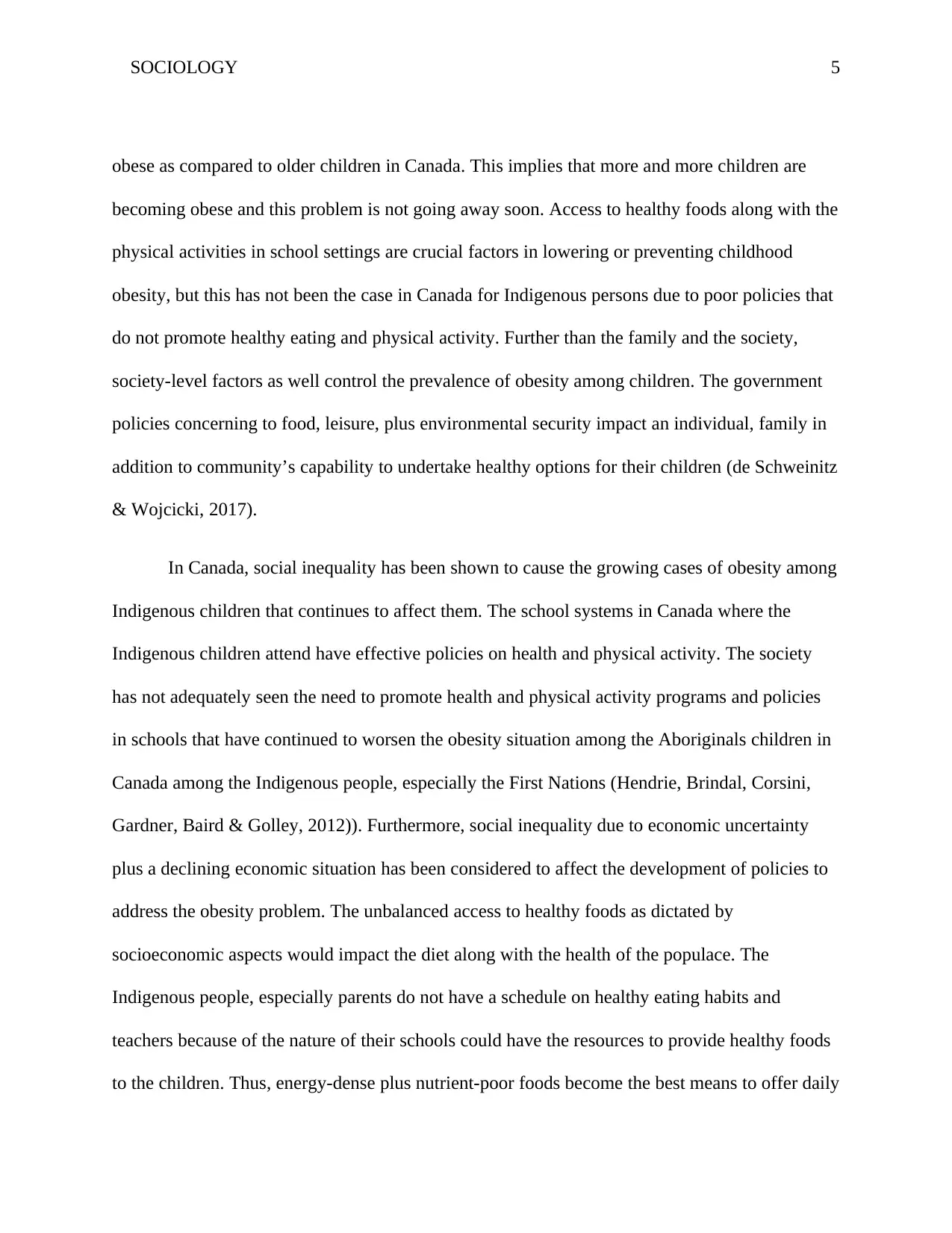
SOCIOLOGY 5
obese as compared to older children in Canada. This implies that more and more children are
becoming obese and this problem is not going away soon. Access to healthy foods along with the
physical activities in school settings are crucial factors in lowering or preventing childhood
obesity, but this has not been the case in Canada for Indigenous persons due to poor policies that
do not promote healthy eating and physical activity. Further than the family and the society,
society-level factors as well control the prevalence of obesity among children. The government
policies concerning to food, leisure, plus environmental security impact an individual, family in
addition to community’s capability to undertake healthy options for their children (de Schweinitz
& Wojcicki, 2017).
In Canada, social inequality has been shown to cause the growing cases of obesity among
Indigenous children that continues to affect them. The school systems in Canada where the
Indigenous children attend have effective policies on health and physical activity. The society
has not adequately seen the need to promote health and physical activity programs and policies
in schools that have continued to worsen the obesity situation among the Aboriginals children in
Canada among the Indigenous people, especially the First Nations (Hendrie, Brindal, Corsini,
Gardner, Baird & Golley, 2012)). Furthermore, social inequality due to economic uncertainty
plus a declining economic situation has been considered to affect the development of policies to
address the obesity problem. The unbalanced access to healthy foods as dictated by
socioeconomic aspects would impact the diet along with the health of the populace. The
Indigenous people, especially parents do not have a schedule on healthy eating habits and
teachers because of the nature of their schools could have the resources to provide healthy foods
to the children. Thus, energy-dense plus nutrient-poor foods become the best means to offer daily
obese as compared to older children in Canada. This implies that more and more children are
becoming obese and this problem is not going away soon. Access to healthy foods along with the
physical activities in school settings are crucial factors in lowering or preventing childhood
obesity, but this has not been the case in Canada for Indigenous persons due to poor policies that
do not promote healthy eating and physical activity. Further than the family and the society,
society-level factors as well control the prevalence of obesity among children. The government
policies concerning to food, leisure, plus environmental security impact an individual, family in
addition to community’s capability to undertake healthy options for their children (de Schweinitz
& Wojcicki, 2017).
In Canada, social inequality has been shown to cause the growing cases of obesity among
Indigenous children that continues to affect them. The school systems in Canada where the
Indigenous children attend have effective policies on health and physical activity. The society
has not adequately seen the need to promote health and physical activity programs and policies
in schools that have continued to worsen the obesity situation among the Aboriginals children in
Canada among the Indigenous people, especially the First Nations (Hendrie, Brindal, Corsini,
Gardner, Baird & Golley, 2012)). Furthermore, social inequality due to economic uncertainty
plus a declining economic situation has been considered to affect the development of policies to
address the obesity problem. The unbalanced access to healthy foods as dictated by
socioeconomic aspects would impact the diet along with the health of the populace. The
Indigenous people, especially parents do not have a schedule on healthy eating habits and
teachers because of the nature of their schools could have the resources to provide healthy foods
to the children. Thus, energy-dense plus nutrient-poor foods become the best means to offer daily
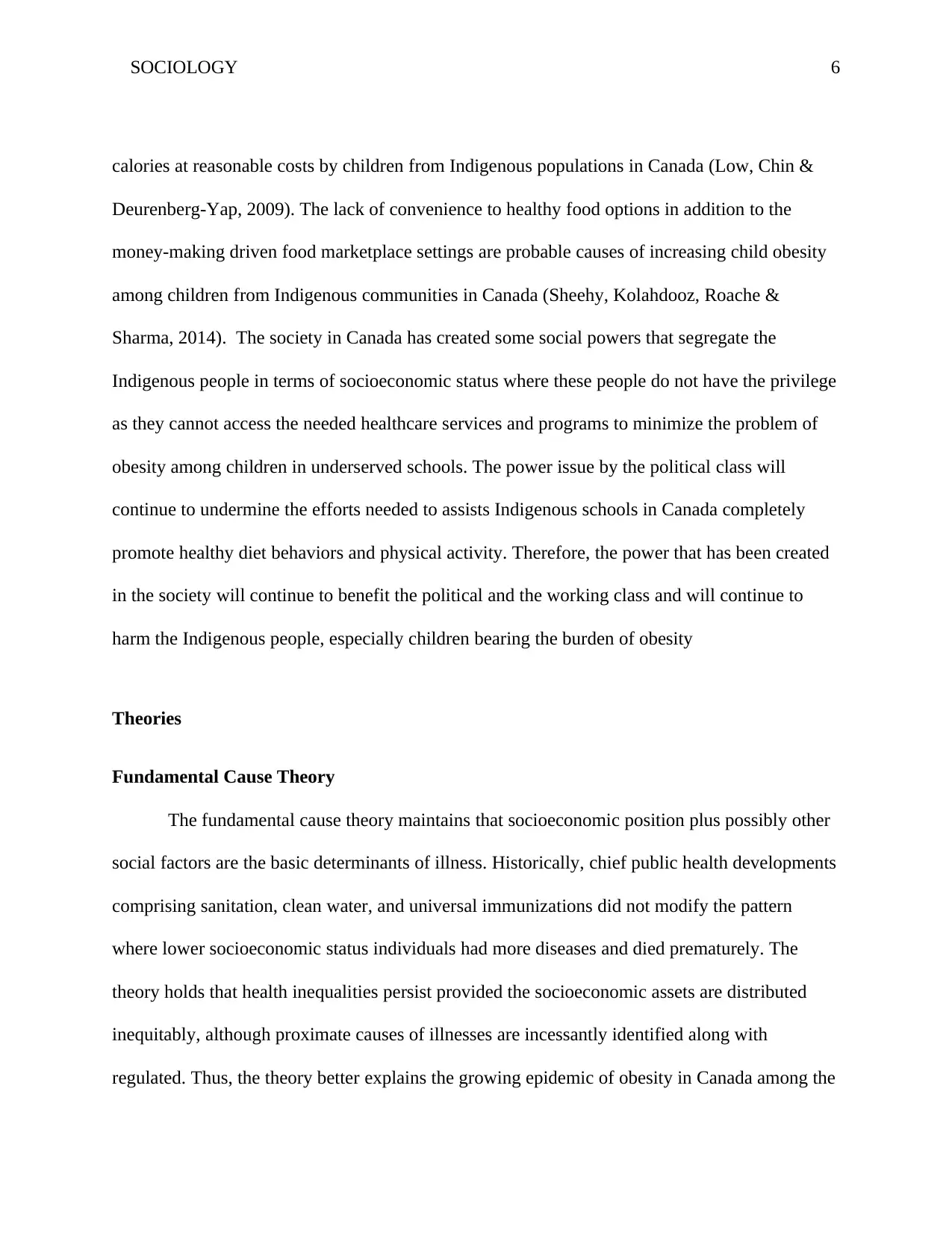
SOCIOLOGY 6
calories at reasonable costs by children from Indigenous populations in Canada (Low, Chin &
Deurenberg-Yap, 2009). The lack of convenience to healthy food options in addition to the
money-making driven food marketplace settings are probable causes of increasing child obesity
among children from Indigenous communities in Canada (Sheehy, Kolahdooz, Roache &
Sharma, 2014). The society in Canada has created some social powers that segregate the
Indigenous people in terms of socioeconomic status where these people do not have the privilege
as they cannot access the needed healthcare services and programs to minimize the problem of
obesity among children in underserved schools. The power issue by the political class will
continue to undermine the efforts needed to assists Indigenous schools in Canada completely
promote healthy diet behaviors and physical activity. Therefore, the power that has been created
in the society will continue to benefit the political and the working class and will continue to
harm the Indigenous people, especially children bearing the burden of obesity
Theories
Fundamental Cause Theory
The fundamental cause theory maintains that socioeconomic position plus possibly other
social factors are the basic determinants of illness. Historically, chief public health developments
comprising sanitation, clean water, and universal immunizations did not modify the pattern
where lower socioeconomic status individuals had more diseases and died prematurely. The
theory holds that health inequalities persist provided the socioeconomic assets are distributed
inequitably, although proximate causes of illnesses are incessantly identified along with
regulated. Thus, the theory better explains the growing epidemic of obesity in Canada among the
calories at reasonable costs by children from Indigenous populations in Canada (Low, Chin &
Deurenberg-Yap, 2009). The lack of convenience to healthy food options in addition to the
money-making driven food marketplace settings are probable causes of increasing child obesity
among children from Indigenous communities in Canada (Sheehy, Kolahdooz, Roache &
Sharma, 2014). The society in Canada has created some social powers that segregate the
Indigenous people in terms of socioeconomic status where these people do not have the privilege
as they cannot access the needed healthcare services and programs to minimize the problem of
obesity among children in underserved schools. The power issue by the political class will
continue to undermine the efforts needed to assists Indigenous schools in Canada completely
promote healthy diet behaviors and physical activity. Therefore, the power that has been created
in the society will continue to benefit the political and the working class and will continue to
harm the Indigenous people, especially children bearing the burden of obesity
Theories
Fundamental Cause Theory
The fundamental cause theory maintains that socioeconomic position plus possibly other
social factors are the basic determinants of illness. Historically, chief public health developments
comprising sanitation, clean water, and universal immunizations did not modify the pattern
where lower socioeconomic status individuals had more diseases and died prematurely. The
theory holds that health inequalities persist provided the socioeconomic assets are distributed
inequitably, although proximate causes of illnesses are incessantly identified along with
regulated. Thus, the theory better explains the growing epidemic of obesity in Canada among the
⊘ This is a preview!⊘
Do you want full access?
Subscribe today to unlock all pages.

Trusted by 1+ million students worldwide
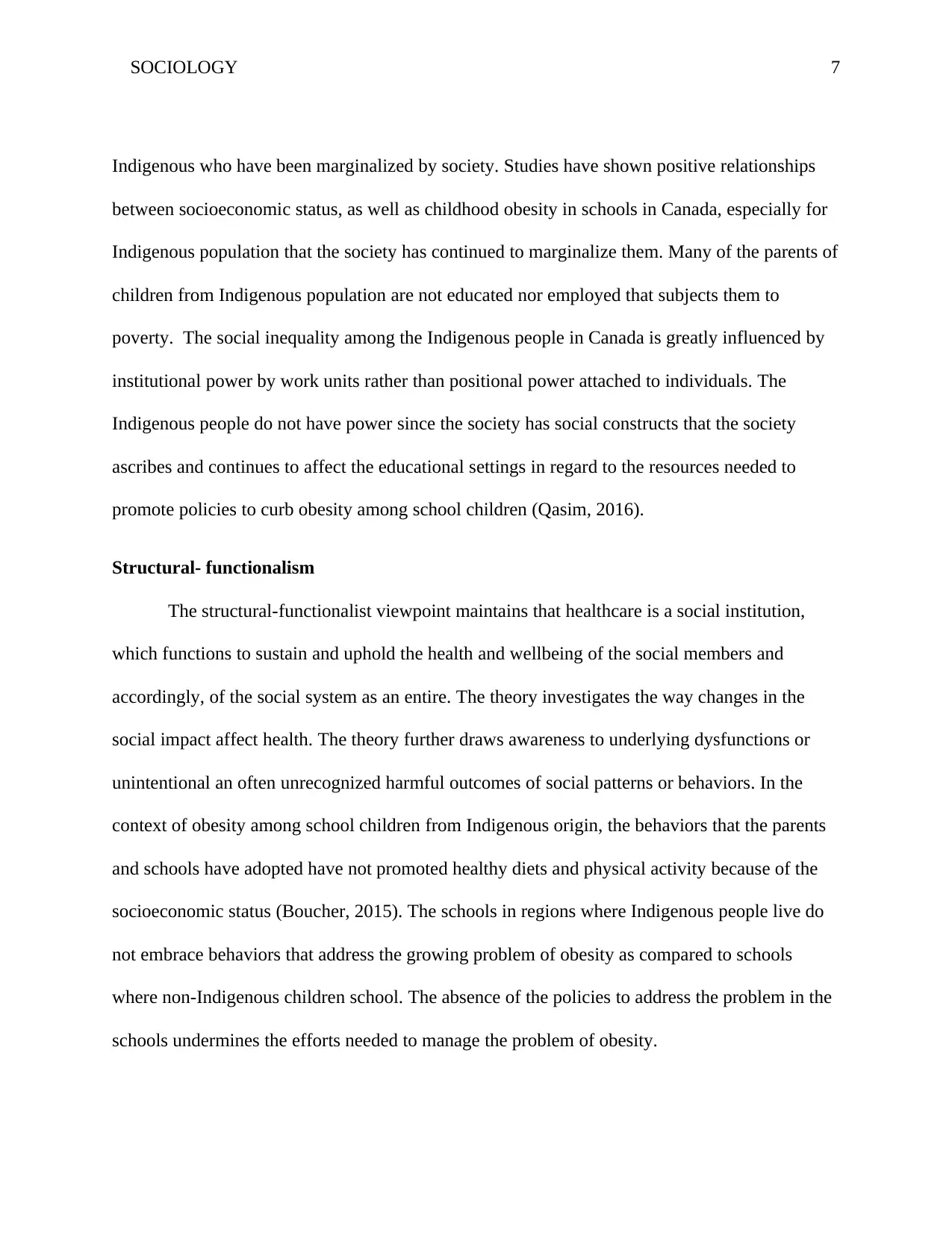
SOCIOLOGY 7
Indigenous who have been marginalized by society. Studies have shown positive relationships
between socioeconomic status, as well as childhood obesity in schools in Canada, especially for
Indigenous population that the society has continued to marginalize them. Many of the parents of
children from Indigenous population are not educated nor employed that subjects them to
poverty. The social inequality among the Indigenous people in Canada is greatly influenced by
institutional power by work units rather than positional power attached to individuals. The
Indigenous people do not have power since the society has social constructs that the society
ascribes and continues to affect the educational settings in regard to the resources needed to
promote policies to curb obesity among school children (Qasim, 2016).
Structural- functionalism
The structural-functionalist viewpoint maintains that healthcare is a social institution,
which functions to sustain and uphold the health and wellbeing of the social members and
accordingly, of the social system as an entire. The theory investigates the way changes in the
social impact affect health. The theory further draws awareness to underlying dysfunctions or
unintentional an often unrecognized harmful outcomes of social patterns or behaviors. In the
context of obesity among school children from Indigenous origin, the behaviors that the parents
and schools have adopted have not promoted healthy diets and physical activity because of the
socioeconomic status (Boucher, 2015). The schools in regions where Indigenous people live do
not embrace behaviors that address the growing problem of obesity as compared to schools
where non-Indigenous children school. The absence of the policies to address the problem in the
schools undermines the efforts needed to manage the problem of obesity.
Indigenous who have been marginalized by society. Studies have shown positive relationships
between socioeconomic status, as well as childhood obesity in schools in Canada, especially for
Indigenous population that the society has continued to marginalize them. Many of the parents of
children from Indigenous population are not educated nor employed that subjects them to
poverty. The social inequality among the Indigenous people in Canada is greatly influenced by
institutional power by work units rather than positional power attached to individuals. The
Indigenous people do not have power since the society has social constructs that the society
ascribes and continues to affect the educational settings in regard to the resources needed to
promote policies to curb obesity among school children (Qasim, 2016).
Structural- functionalism
The structural-functionalist viewpoint maintains that healthcare is a social institution,
which functions to sustain and uphold the health and wellbeing of the social members and
accordingly, of the social system as an entire. The theory investigates the way changes in the
social impact affect health. The theory further draws awareness to underlying dysfunctions or
unintentional an often unrecognized harmful outcomes of social patterns or behaviors. In the
context of obesity among school children from Indigenous origin, the behaviors that the parents
and schools have adopted have not promoted healthy diets and physical activity because of the
socioeconomic status (Boucher, 2015). The schools in regions where Indigenous people live do
not embrace behaviors that address the growing problem of obesity as compared to schools
where non-Indigenous children school. The absence of the policies to address the problem in the
schools undermines the efforts needed to manage the problem of obesity.
Paraphrase This Document
Need a fresh take? Get an instant paraphrase of this document with our AI Paraphraser
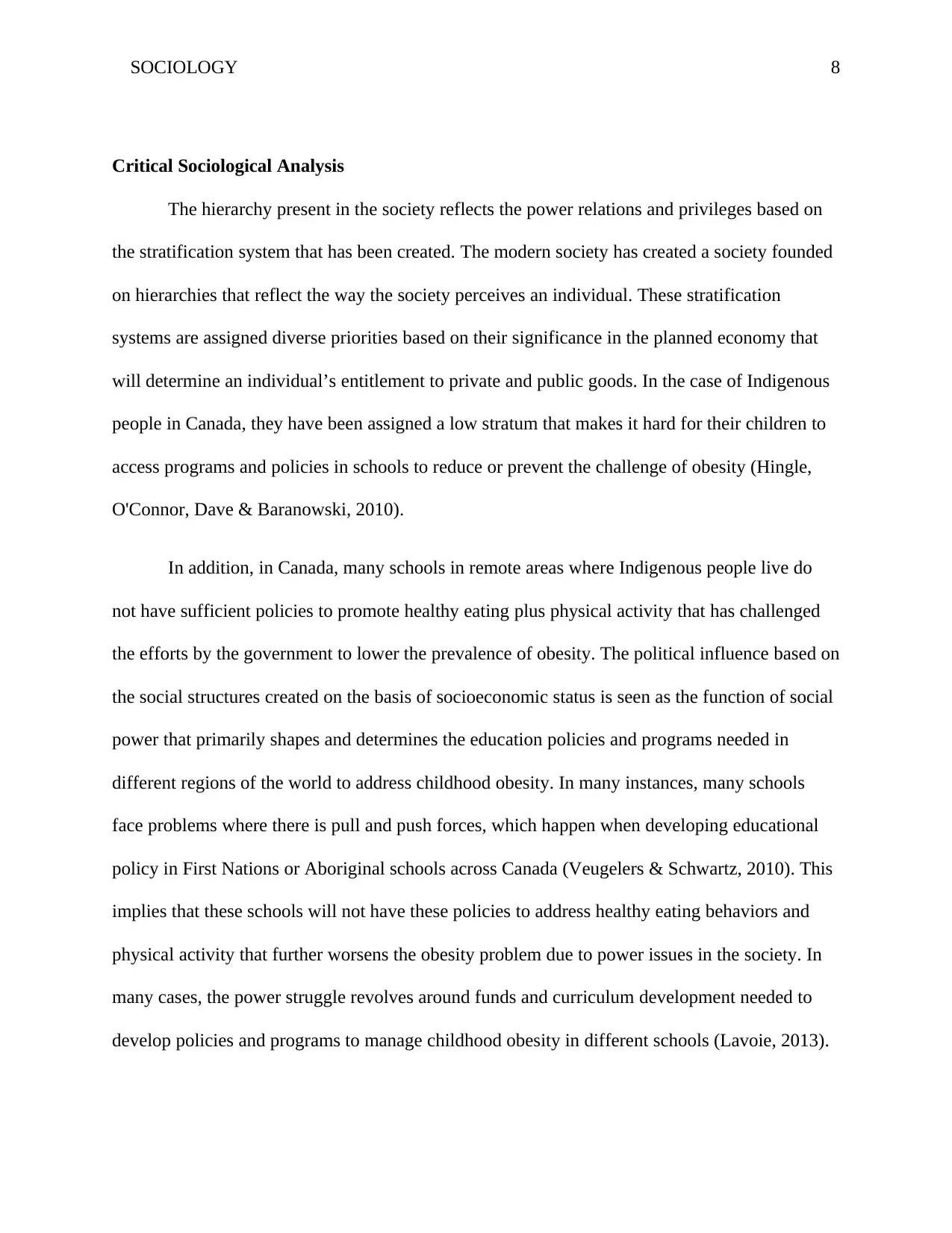
SOCIOLOGY 8
Critical Sociological Analysis
The hierarchy present in the society reflects the power relations and privileges based on
the stratification system that has been created. The modern society has created a society founded
on hierarchies that reflect the way the society perceives an individual. These stratification
systems are assigned diverse priorities based on their significance in the planned economy that
will determine an individual’s entitlement to private and public goods. In the case of Indigenous
people in Canada, they have been assigned a low stratum that makes it hard for their children to
access programs and policies in schools to reduce or prevent the challenge of obesity (Hingle,
O'Connor, Dave & Baranowski, 2010).
In addition, in Canada, many schools in remote areas where Indigenous people live do
not have sufficient policies to promote healthy eating plus physical activity that has challenged
the efforts by the government to lower the prevalence of obesity. The political influence based on
the social structures created on the basis of socioeconomic status is seen as the function of social
power that primarily shapes and determines the education policies and programs needed in
different regions of the world to address childhood obesity. In many instances, many schools
face problems where there is pull and push forces, which happen when developing educational
policy in First Nations or Aboriginal schools across Canada (Veugelers & Schwartz, 2010). This
implies that these schools will not have these policies to address healthy eating behaviors and
physical activity that further worsens the obesity problem due to power issues in the society. In
many cases, the power struggle revolves around funds and curriculum development needed to
develop policies and programs to manage childhood obesity in different schools (Lavoie, 2013).
Critical Sociological Analysis
The hierarchy present in the society reflects the power relations and privileges based on
the stratification system that has been created. The modern society has created a society founded
on hierarchies that reflect the way the society perceives an individual. These stratification
systems are assigned diverse priorities based on their significance in the planned economy that
will determine an individual’s entitlement to private and public goods. In the case of Indigenous
people in Canada, they have been assigned a low stratum that makes it hard for their children to
access programs and policies in schools to reduce or prevent the challenge of obesity (Hingle,
O'Connor, Dave & Baranowski, 2010).
In addition, in Canada, many schools in remote areas where Indigenous people live do
not have sufficient policies to promote healthy eating plus physical activity that has challenged
the efforts by the government to lower the prevalence of obesity. The political influence based on
the social structures created on the basis of socioeconomic status is seen as the function of social
power that primarily shapes and determines the education policies and programs needed in
different regions of the world to address childhood obesity. In many instances, many schools
face problems where there is pull and push forces, which happen when developing educational
policy in First Nations or Aboriginal schools across Canada (Veugelers & Schwartz, 2010). This
implies that these schools will not have these policies to address healthy eating behaviors and
physical activity that further worsens the obesity problem due to power issues in the society. In
many cases, the power struggle revolves around funds and curriculum development needed to
develop policies and programs to manage childhood obesity in different schools (Lavoie, 2013).
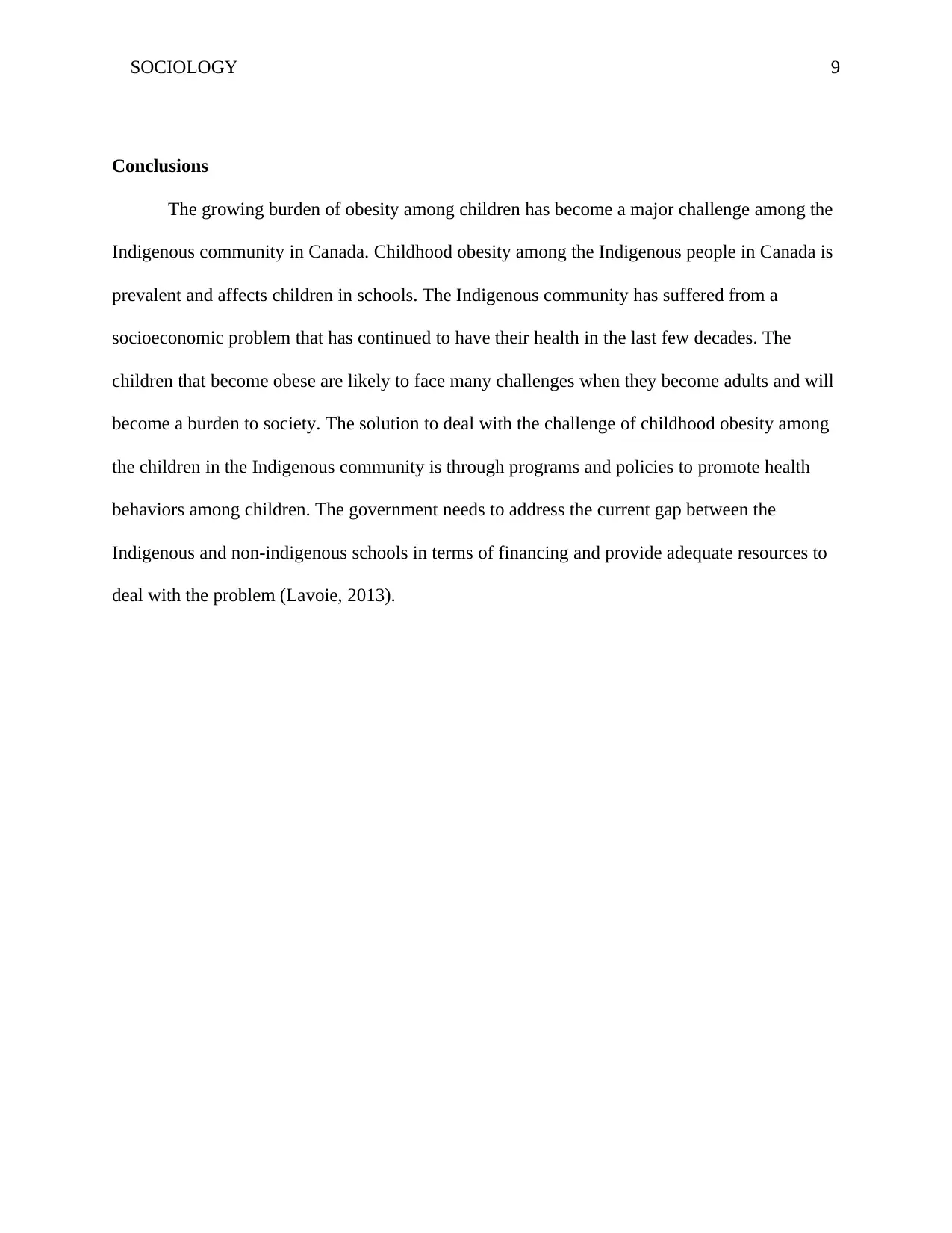
SOCIOLOGY 9
Conclusions
The growing burden of obesity among children has become a major challenge among the
Indigenous community in Canada. Childhood obesity among the Indigenous people in Canada is
prevalent and affects children in schools. The Indigenous community has suffered from a
socioeconomic problem that has continued to have their health in the last few decades. The
children that become obese are likely to face many challenges when they become adults and will
become a burden to society. The solution to deal with the challenge of childhood obesity among
the children in the Indigenous community is through programs and policies to promote health
behaviors among children. The government needs to address the current gap between the
Indigenous and non-indigenous schools in terms of financing and provide adequate resources to
deal with the problem (Lavoie, 2013).
Conclusions
The growing burden of obesity among children has become a major challenge among the
Indigenous community in Canada. Childhood obesity among the Indigenous people in Canada is
prevalent and affects children in schools. The Indigenous community has suffered from a
socioeconomic problem that has continued to have their health in the last few decades. The
children that become obese are likely to face many challenges when they become adults and will
become a burden to society. The solution to deal with the challenge of childhood obesity among
the children in the Indigenous community is through programs and policies to promote health
behaviors among children. The government needs to address the current gap between the
Indigenous and non-indigenous schools in terms of financing and provide adequate resources to
deal with the problem (Lavoie, 2013).
⊘ This is a preview!⊘
Do you want full access?
Subscribe today to unlock all pages.

Trusted by 1+ million students worldwide
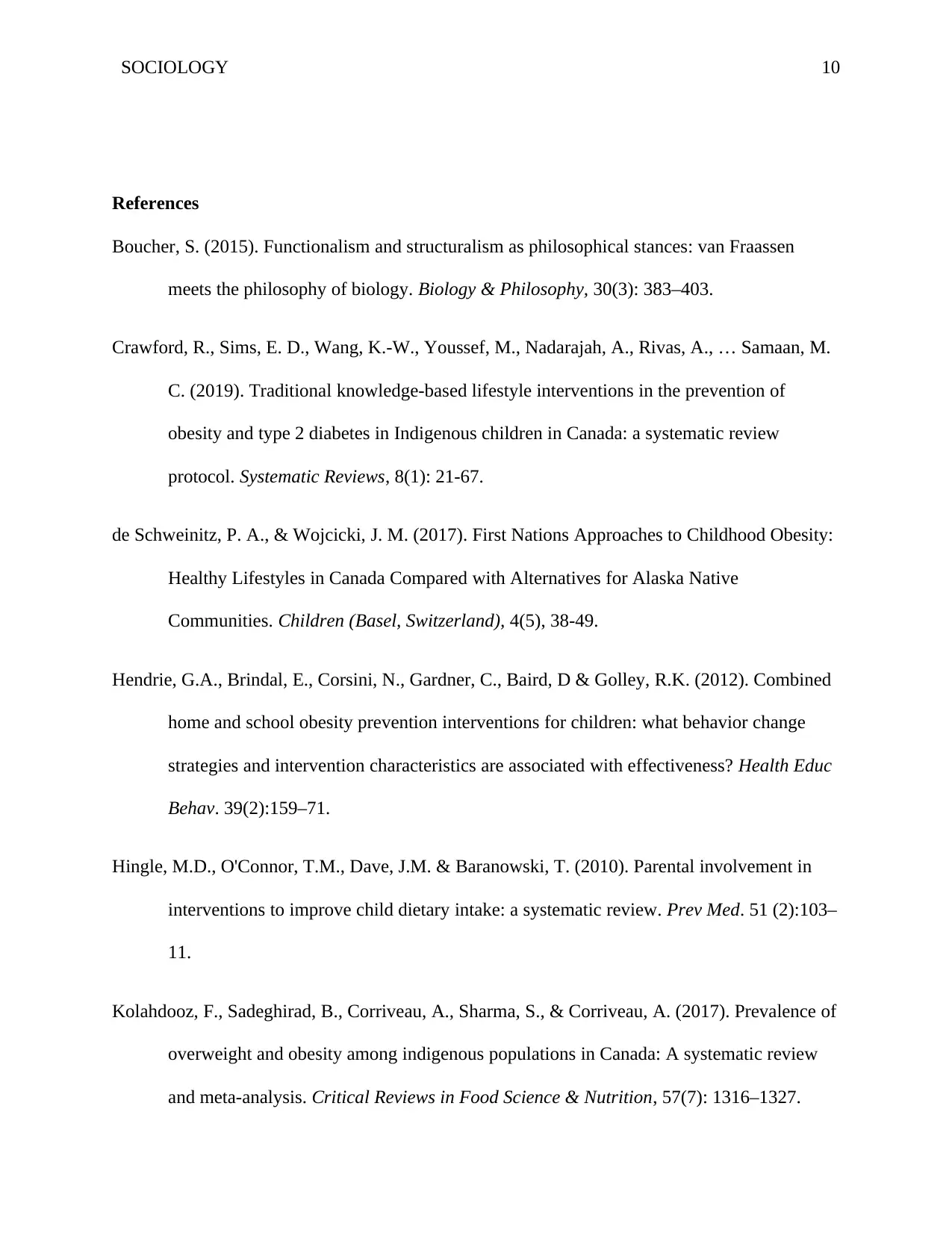
SOCIOLOGY 10
References
Boucher, S. (2015). Functionalism and structuralism as philosophical stances: van Fraassen
meets the philosophy of biology. Biology & Philosophy, 30(3): 383–403.
Crawford, R., Sims, E. D., Wang, K.-W., Youssef, M., Nadarajah, A., Rivas, A., … Samaan, M.
C. (2019). Traditional knowledge-based lifestyle interventions in the prevention of
obesity and type 2 diabetes in Indigenous children in Canada: a systematic review
protocol. Systematic Reviews, 8(1): 21-67.
de Schweinitz, P. A., & Wojcicki, J. M. (2017). First Nations Approaches to Childhood Obesity:
Healthy Lifestyles in Canada Compared with Alternatives for Alaska Native
Communities. Children (Basel, Switzerland), 4(5), 38-49.
Hendrie, G.A., Brindal, E., Corsini, N., Gardner, C., Baird, D & Golley, R.K. (2012). Combined
home and school obesity prevention interventions for children: what behavior change
strategies and intervention characteristics are associated with effectiveness? Health Educ
Behav. 39(2):159–71.
Hingle, M.D., O'Connor, T.M., Dave, J.M. & Baranowski, T. (2010). Parental involvement in
interventions to improve child dietary intake: a systematic review. Prev Med. 51 (2):103–
11.
Kolahdooz, F., Sadeghirad, B., Corriveau, A., Sharma, S., & Corriveau, A. (2017). Prevalence of
overweight and obesity among indigenous populations in Canada: A systematic review
and meta-analysis. Critical Reviews in Food Science & Nutrition, 57(7): 1316–1327.
References
Boucher, S. (2015). Functionalism and structuralism as philosophical stances: van Fraassen
meets the philosophy of biology. Biology & Philosophy, 30(3): 383–403.
Crawford, R., Sims, E. D., Wang, K.-W., Youssef, M., Nadarajah, A., Rivas, A., … Samaan, M.
C. (2019). Traditional knowledge-based lifestyle interventions in the prevention of
obesity and type 2 diabetes in Indigenous children in Canada: a systematic review
protocol. Systematic Reviews, 8(1): 21-67.
de Schweinitz, P. A., & Wojcicki, J. M. (2017). First Nations Approaches to Childhood Obesity:
Healthy Lifestyles in Canada Compared with Alternatives for Alaska Native
Communities. Children (Basel, Switzerland), 4(5), 38-49.
Hendrie, G.A., Brindal, E., Corsini, N., Gardner, C., Baird, D & Golley, R.K. (2012). Combined
home and school obesity prevention interventions for children: what behavior change
strategies and intervention characteristics are associated with effectiveness? Health Educ
Behav. 39(2):159–71.
Hingle, M.D., O'Connor, T.M., Dave, J.M. & Baranowski, T. (2010). Parental involvement in
interventions to improve child dietary intake: a systematic review. Prev Med. 51 (2):103–
11.
Kolahdooz, F., Sadeghirad, B., Corriveau, A., Sharma, S., & Corriveau, A. (2017). Prevalence of
overweight and obesity among indigenous populations in Canada: A systematic review
and meta-analysis. Critical Reviews in Food Science & Nutrition, 57(7): 1316–1327.
Paraphrase This Document
Need a fresh take? Get an instant paraphrase of this document with our AI Paraphraser
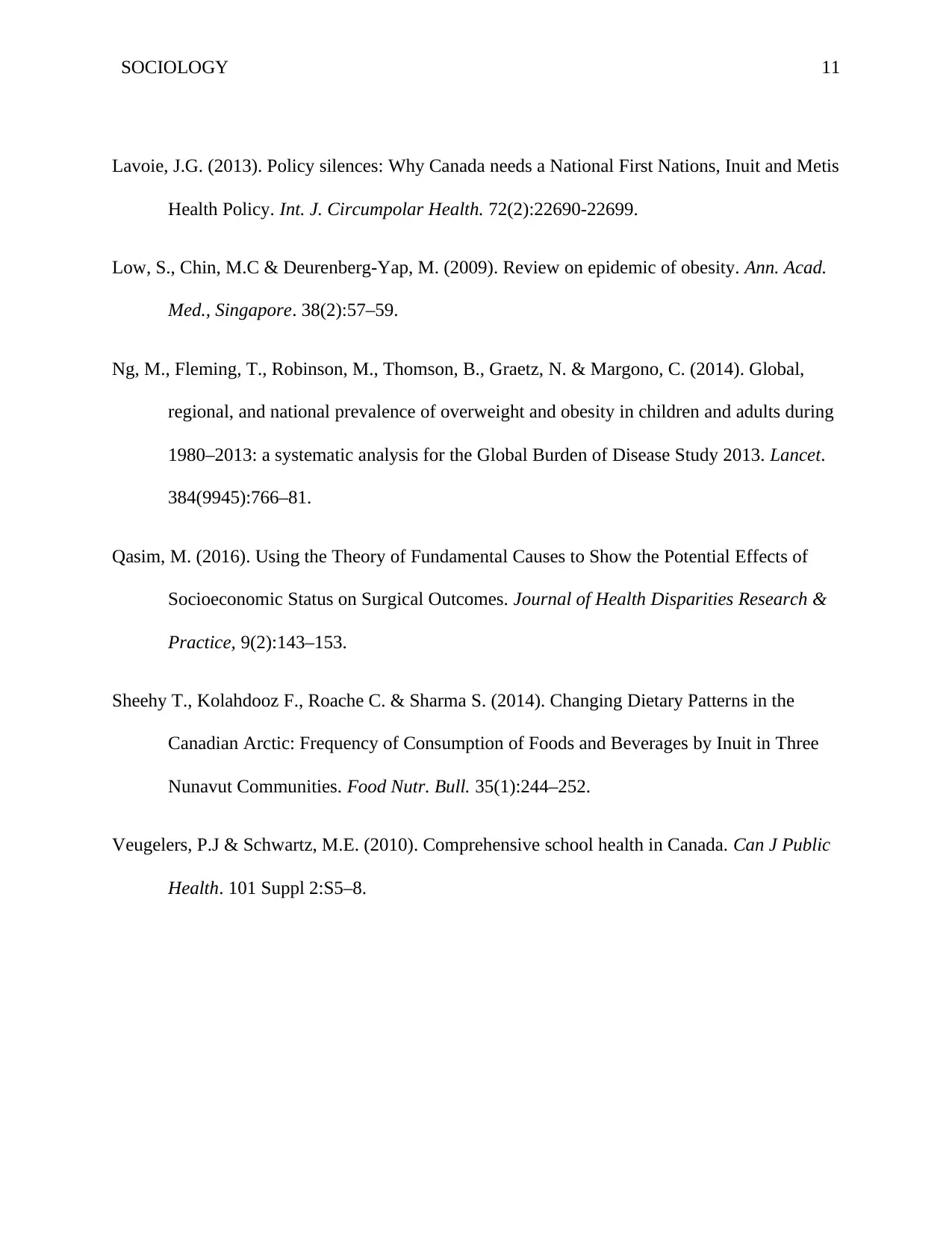
SOCIOLOGY 11
Lavoie, J.G. (2013). Policy silences: Why Canada needs a National First Nations, Inuit and Metis
Health Policy. Int. J. Circumpolar Health. 72(2):22690-22699.
Low, S., Chin, M.C & Deurenberg-Yap, M. (2009). Review on epidemic of obesity. Ann. Acad.
Med., Singapore. 38(2):57–59.
Ng, M., Fleming, T., Robinson, M., Thomson, B., Graetz, N. & Margono, C. (2014). Global,
regional, and national prevalence of overweight and obesity in children and adults during
1980–2013: a systematic analysis for the Global Burden of Disease Study 2013. Lancet.
384(9945):766–81.
Qasim, M. (2016). Using the Theory of Fundamental Causes to Show the Potential Effects of
Socioeconomic Status on Surgical Outcomes. Journal of Health Disparities Research &
Practice, 9(2):143–153.
Sheehy T., Kolahdooz F., Roache C. & Sharma S. (2014). Changing Dietary Patterns in the
Canadian Arctic: Frequency of Consumption of Foods and Beverages by Inuit in Three
Nunavut Communities. Food Nutr. Bull. 35(1):244–252.
Veugelers, P.J & Schwartz, M.E. (2010). Comprehensive school health in Canada. Can J Public
Health. 101 Suppl 2:S5–8.
Lavoie, J.G. (2013). Policy silences: Why Canada needs a National First Nations, Inuit and Metis
Health Policy. Int. J. Circumpolar Health. 72(2):22690-22699.
Low, S., Chin, M.C & Deurenberg-Yap, M. (2009). Review on epidemic of obesity. Ann. Acad.
Med., Singapore. 38(2):57–59.
Ng, M., Fleming, T., Robinson, M., Thomson, B., Graetz, N. & Margono, C. (2014). Global,
regional, and national prevalence of overweight and obesity in children and adults during
1980–2013: a systematic analysis for the Global Burden of Disease Study 2013. Lancet.
384(9945):766–81.
Qasim, M. (2016). Using the Theory of Fundamental Causes to Show the Potential Effects of
Socioeconomic Status on Surgical Outcomes. Journal of Health Disparities Research &
Practice, 9(2):143–153.
Sheehy T., Kolahdooz F., Roache C. & Sharma S. (2014). Changing Dietary Patterns in the
Canadian Arctic: Frequency of Consumption of Foods and Beverages by Inuit in Three
Nunavut Communities. Food Nutr. Bull. 35(1):244–252.
Veugelers, P.J & Schwartz, M.E. (2010). Comprehensive school health in Canada. Can J Public
Health. 101 Suppl 2:S5–8.
1 out of 11
Related Documents
Your All-in-One AI-Powered Toolkit for Academic Success.
+13062052269
info@desklib.com
Available 24*7 on WhatsApp / Email
![[object Object]](/_next/static/media/star-bottom.7253800d.svg)
Unlock your academic potential
Copyright © 2020–2025 A2Z Services. All Rights Reserved. Developed and managed by ZUCOL.





